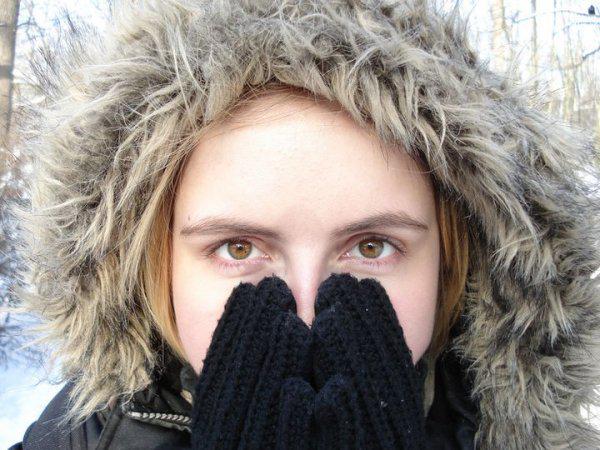685
Dress CABBAGE

In cold weekend severely frostbitten about 16 Muscovites, but then doctors have recorded one case of fatal - a man frozen to death on the street. Most affected residents required hospitalization. Now freeze at least - it seems to frost Muscovites somehow adapted.
Doctors advise citizens in the cold to be especially attentive to their health and adhere to the rules of the banal. First, you need to put on the principle of "cabbage", as in several layers of clothes keeps the heat better. Second, the shoes should not be narrow. At the close shoes feet freeze faster. Well, when you've thoroughly podmerzli, you do not need to rub the frostbitten limbs snow or grease. We need to do a warm (not hot!) Bath or apply again warm cotton-gauze dressings.
In addition, doctors pay attention to the fact that the frostbite - an insidious thing. And the first 12 - 20 hours of frostbite, such as, of course, can almost does not manifest itself. Therefore it is better to err and consult a doctor if too cold.
Frostbite is a reactive inflammation and necrosis of tissue resulting from circulatory disorders under the influence of low temperatures. More often exposed to frostbite poorly protected from the cold peripheral parts of the body - fingers, toes, nose, ears, cheeks. Please note that frostbite can occur are not necessarily under the influence of negative temperatures, but also at a temperature close to zero, in the presence of high humidity and wind (frequent frostbite feet fishermen, sailors frostbite during shipwrecks). Promotes compression frostbitten feet tight shoes, ski bindings or prolonged squeezing something in his hands (arms control levers, etc.), resulting in blood circulation. Factors predisposing to frostbite, a general weakening of the body due to blood loss, starvation, vitamin deficiency and fatigue. More than 60% of the victims get frostbite while intoxicated. Significantly higher risk of frostbite in people suffering from obliterating diseases of the lower extremities, venous diseases, diabetes. In addition, the bad effect repeated exposure to low temperatures (repeated frostbite).
The continuing effect of the cold leads to the first extension (cheek - ruddy ears - red), and then to a spasm of blood vessels, resulting in impaired tissue nutrition, and we see the whitening of the skin area. The man thus can feel pain, numbness, or may not feel anything ("Oh, you have white spots on their cheeks!"). Outwardly, at this stage it is impossible to determine the degree of frostbite: you can only assume that the lower the temperature and duration of exposure, the worse. When warming vasospasm replaced paralytic vasodilatation (the so-called reactive period). It was during this period, and is the main tissue destruction. Specific symptoms, allowing to determine the degree of frostbite, usually appear in full by the end of the first day. Depending on the depth of the lesion providing 4 degree frostbite.
I degree different skin lesions in the form of reversible disorders of blood circulation. After warming the skin becomes pale bluish-red, painful and edematous. Painful events pass in a few days, but frostbite of the body for a long time remained sensitive to low temperatures.
Grade II is characterized by the appearance on the affected area on a background of red and cyanotic skin blisters filled with turbid fluid. Pronounced pain. Recovery occurs within 2-3 weeks.
Grade III is allocated the entire thickness of skin necrosis. On the red-cyanotic, edematous, compacted skin appear foci of necrosis (tissue necrosis), bubbles filled with a dark liquid. After the rejection of dead tissue wound surface is reduced scarring (1-2 months), with extensive lesions require dermepenthesis.
Grade IV lesion is characterized by thickness of soft tissue and bone with the development of gangrene. Treatment consists of surgical removal of dead tissue (with extensive lesions - amputation). During the natural course of dead tissue gradually rejected forming amputation stump heals very long time to form a rough deforming scars.
Along with local frostbite symptoms almost always there is a change of a general nature that are related both to the direct effect of low temperatures on all systems of the body (total freezing), and with the absorption into the blood of the decay products of damaged tissues and the accession of infection. Total freezing occurs at long staying at low temperatures, it develops very rapidly in water. Stay in the icy water for half an hour can be deadly, and the sudden immersion in a cold water shock can occur. General freezing contribute to predisposing factors such as fatigue, hunger, alcohol intoxication, immobility, etc. Starting from freezing at lower total body temperature to 34 * C and flows into the following three phases:
1. adaptive responses - changes in the central nervous system and circulatory system are reversible. At this stage there muscle tremors, frequent breathing and pulse, skin becomes pale.
2. stuporous phase - happening depression of the central nervous system, there is drowsiness, muscle tremors disappeared, and advanced peripheral vessels create a false sense of warmth. The heart rate decreases, blood pressure drops, breathing becomes shallow.
3. Phase extinction of vital functions - continued oppression of all the major functions of the body, the victim loses consciousness, occur cramps, numbness, and in the absence of aid - death. You must know that death during freezing is very slow, and the duration of clinical death (ie the period when resuscitation can still be effective) is significantly superior to that of other conditions, and is strongly dependent on body temperature and ambient temperature.
























